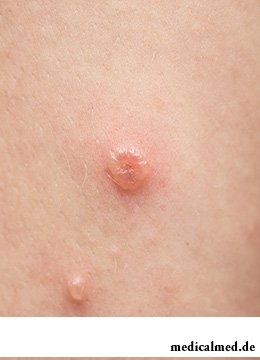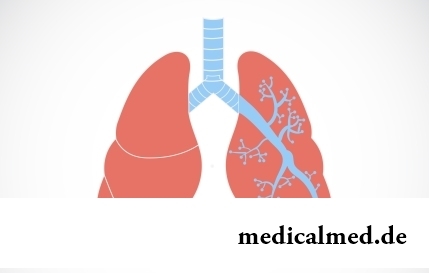





Granuloma
 Granuloma call the limited accumulation of cells of young connecting fabric reminding by the form a small knot of the small size. Such educations appear at defeat of an organism by various infectious agents (tuberculosis, syphilis, rage, etc.) or collagenic diseases (for example, rheumatism). Besides, they develop in the place of hit of a foreign body in integuments and mucous.
Granuloma call the limited accumulation of cells of young connecting fabric reminding by the form a small knot of the small size. Such educations appear at defeat of an organism by various infectious agents (tuberculosis, syphilis, rage, etc.) or collagenic diseases (for example, rheumatism). Besides, they develop in the place of hit of a foreign body in integuments and mucous.
Origin of granulomas
The etiology of granulomas is various. One of classifications of these educations is based on their origin:
- Noninfectious;
- Infectious;
- Unspecified genesis.
Noninfectious granulomas appear as a result of medicamentous influences (granulematozny hepatitises) or occupational dust diseases (a talcosis, a silicosis, asbestosis, etc.). They develop and around various foreign bodys.
Treatment of granulomas of infectious character (is closely connected with an origin at belly and a sapropyra, a tularemia, rage, syphilis, viral encephalitis, tuberculosis, etc.) as it is possible to get rid of the small centers of an inflammation only having destroyed the activator which caused them.
New growths at Horton's diseases belong to granulomas of the unspecified nature and Krone, a sarcoidosis, Wegener's granulomatosis.
Types of granulomas
In classification by morphological features allocate three main types of granulomas:
- Epithelioid and cellular, or epitelioidotsitoma;
- Macrophagic, or fagotsitoma;
- Giant-cell.
On a metabolic rate distinguish educations with the high and low level of a metabolism. The first appear under the influence of toxic agents (a leprosy, a tuberculosis mycobacterium, etc.) and are epithelioid and cellular small knots. The second arise under the influence of inert bodies and consist of colossal cells of foreign substances.
Even on one classification of a granuloma divide into two groups:
- Specific which morphology is characteristic of a specific infectious disease. At a research from the expanded cells it is possible to allocate the activator. Treat this group a ring-shaped, leprose, tubercular, skleromny, syphilitic granuloma;
- Nonspecific, not having any characteristic features. Arise as at infectious diseases (sypny and a typhoid, a leushmaniosis), and at noninfectious diseases (a silicosis, asbestosis).
It is possible to consider features of a disease on the example of two interesting kinds of granulomas: eosinophilic and piogenic.
Piogenic granulomas (botryomycomas)
Represent slightly raised formations of scarlet, brown or blue-black color. Growth of piogenic granulomas is caused by hypostasis of surrounding fabric and the accelerated development of a capillary network owing to injuries – cuts, grazes or pricks.
The disease develops promptly. Sometimes piogenic granulomas begin to bleed slightly as the skin closing them very thin. On unknown so far to the reasons similar educations can develop at pregnant women, but arise at adults up to 30 years and children more often.
Treat characteristic symptoms of a granuloma:
- Bright red, dark red, violet or brown-black color;
- Dense consistence;
- The shining, slightly bleeding surface;
- The size in the diameter up to 1,5 cm;
- Arrangement – on lips and gums, mucous a nose and fingers;
- Initial growth, and then insignificant reduction in sizes.
Usually piogenic granuloma disappears independently, but if it does not vanish, then it is recommended to make a biopsy and to make sure that the new growth is not malignant.
Effective treatment of a granuloma – surgical as conservative actions (use of ointments, brilliant green) do not yield a positive take. Education is excised, and its basis is scraped out special acute "spoon" then put stitches. Operation is performed under local anesthesia, the probability of a recurrence is minimum.
Eosinophilic granuloma (Taratynov's disease)
Represents the disease of not clear etiology which is characterized by emergence in bones of infiltrates which are rich with eosinophilic granulocytes. The disease meets seldom, children of preschool age have it, as a rule.
Eosinophilic granulomas are single or multiple centers in tubular and flat bones. Most often femoral, haunch, cranial bones and vertebrae are surprised.
Initial symptoms of a granuloma are the swelling and morbidity in the struck area. If the disease arises in skull bones, then the swelled up a little site becomes soft, and the edge of bone defect is probed as the crateriform thickening. At development of defect in long tubular bones the club-shaped thickening is palpated. Integuments over a swelling are usually not changed.
From other symptoms of a granuloma it is possible to note burning and an itch, and also hypersensitivity in places of defeat.
In general a condition of the patient satisfactory, some patients complain of headaches and unpleasant feelings at the movement.
 The eosinophilic granuloma develops slowly, the course of a disease chronic, progresses in rare instances. Sometimes the disease accompanies the person for years, at the same time zones of defeat are already not so noticeable and change coloring, especially under the influence of ultra-violet radiation. At the extensive destructive centers formation of nearthroses and pathological changes are possible.
The eosinophilic granuloma develops slowly, the course of a disease chronic, progresses in rare instances. Sometimes the disease accompanies the person for years, at the same time zones of defeat are already not so noticeable and change coloring, especially under the influence of ultra-violet radiation. At the extensive destructive centers formation of nearthroses and pathological changes are possible.
Apply the following methods of treatment of a granuloma:
- Roentgenotherapy of the centers of damage of a bone tissue;
- Surgical treatment (scraping, or curettage);
- Radiation therapy;
- Chemotherapy;
- Cryotherapy;
- Medicamentous therapy by drugs leukeranum, Vincristinum, Chlorbutinum, etc. (at acute manifestations).
As cases of spontaneous recovery are known, before use of the above described methods waiting tactics with careful observation of the patient in a hospital is used.
If your liver ceased to work, death would come within a day.

There is a lot of fans of beer in our country. Statistically, on each average Russian (including women and children) in...
Section: Articles about health
Beauty shop – the place which is associated only with positive emotions: joy, pleasure, relaxation. However visit of salon where work with biological material of clients, not always harmlessly is conducted. Today it is known Bol...
Section: Articles about health
"Epilepsy" doctors made the diagnosis in antique times. Displays of an illness and pattern of its development are very well studied. However for nonspecialists this disease remains to not less mysterious, than in the ancient time. Many delusions are connected with epilepsy, and it sometimes very unpleasantly affects quality of life of patients and their relatives. In this article we will try to dispel the most known of similar myths....
Section: Articles about health
Energy saving lamps are one of the most popular products of innovative technologies, and there is no wonder: they much эк...
Section: Articles about health
They say that to ensure health and longevity of people it is obliged. Really, at competent approach to these questions, minimization of an adverse effect of many factors does not represent a special problem. Practically everyone has an opportunity to play sports...
Section: Articles about health
For many women the word "fat" sounds as a sentence. In aspiration to an ideal figure they try to exclude, first of all, from the menu all dishes containing fats without having at the same time a clear idea of a role of these substances in exchange processes, and of effects for health with which food restrictions of this sort are fraught. For what the human body needs fats and as their deficit in a diet is shown, we also will try to find out....
Section: Articles about health
Tea is loved and use almost everything. This drink has tonic properties, contains the tannins capable podavlit...
Section: Articles about health
Heart disease and blood vessels lead to disturbance of blood supply of bodies and fabrics that involves failures in their work, deterioration in health of the person, decrease in its working capacity and standard of living. Annually such perishes from pathologies more...
Section: Articles about health
Statistically, in Russia about 34% of citizens smoke. Most of consumers of tobacco has problems with health sooner or later. Not only smokers, but also their relatives suffer. Besides, cigarettes are expensive, and need of their acquisition goes a heavy burden on the budget of thousands of Russian families. Many people dream to refuse harmful tendency, but everyone manages to make it not: nicotine addiction is affectionate and to get rid of it not easy....
Section: Articles about health
The next flu epidemic leads to the next panic, from year to year we give in on these manipulations: professionally alarming goal...
Section: Articles about health
For most of the working people the problem of having a snack is particularly acute enough. Sooner or later there is a question: what can be eaten quickly between a breakfast and a lunch or a lunch and leaving from service so that to receive necessary power feed, but not an overload...
Section: Articles about health
The drugs stopping or oppressing life activity of pathogenic microorganisms are widely applied in clinical practice from 40th years of the last century. Originally antibiotics were called only substances natural (animal, vegetable or microbic) origins, but over time this concept extended, and it includes also semi-synthetic and completely artificial antibacterial drugs....
Section: Articles about health
Memory is an ability of the central nervous system to fix, keep and as necessary to reproduce information on knowledge...
Section: Articles about health
Each of us faces from time to time that other people need the immediate help. We react to it differently: one at once call doctors and police, others rush to victims and try to save them independently. Some at all...
Section: Articles about health
In consciousness of our many compatriots idea that folk remedies if are no more effective, than medicinal "chemistry" strongly took roots, then are precisely less harmful. Unfortunately, it is not always fair: some methods of treatment consecrated with "century national experience" can work so on the patient that it will need urgent intervention of physicians....
Section: Articles about health
Deciding to get rid of an addiction, not all imagine what effects it is necessary to face. Process of refusal from ку...
Section: Articles about health
Bulimia and anorexia, are heavy deviations of a feeding behavior, become a cause of death of patients much more often than all other nervous breakdowns combined. In 60% of cases two illnesses accompany each other: patients feel horror before danger on...
Section: Articles about health
For anybody not a secret that our country is one of the most "drinking" in the world. At clear understanding that the use of hard alcoholic drinks – occupation extremely harmful, most of Russians belong to alcoholism with unjustified loyalty. Apparently, existence of a set of myths in which tendency to excessive libations looks nearly positively is explained by it. It is worth getting acquainted with the most widespread of similar delusions and to be convinced in them not...
Section: Articles about health
For anybody not a secret that the modern person eats not as his ancestors. For the last 100 years in broad access appeared with...
Section: Articles about health
Each person knows that fervescence is an illness sign. However too low temperature (hypothermia), especially also can demonstrate existence of diseases when it is observed long enough. Such state is dangerous those...
Section: Articles about health
It is possible to find the extensive range of fruit and vegetables in modern shops. Russians already got used that on counters there is not only a seasonal domestic production, but the vegetables and fruit which are grown up in the countries with more comfortable conditions of cultivation at all seasons of the year. However what we see in shops and in the vegetable markets, is only a small part of those edible plants with which the nature is so rich. Today we want to acquaint the reader with rare and very useful vegetables which on...
Section: Articles about health
Ability of an organism to resist to adverse environmental factors (to impact of temperature drops, humidity and pressure...
Section: Articles about health
Contrary to popular belief, the multiple sclerosis (MS) is not connected neither with sclerous changes of walls of vessels, nor with age forgetfulness and problems with concentration of attention. This disease has the autoimmune nature. Pathological process of a vyrazh...
Section: Articles about health
All diseases from nerves – in this joke a big element of truth, are said by doctors. Constant stresses lead to decrease in protective forces of an organism, and it becomes vulnerable for a set of diseases. It is wrong to think that the stress is a problem of the present. Life of people and hundred, and one thousand years ago also abounded with problems therefore need of a relaxation understood in ancient times – to some techniques more than one thousand years. The person needs knowledge of how it is possible to relax, this knowledge пригод...
Section: Articles about health
All know that self-treatment is dangerous. However absolutely it is almost impossible to do without it. Rate of modern life not on...
Section: Articles about health
The pine is one of the most widespread plants of our woods. Its needles and pitch not without reason called by "gallipot" were since ancient times used for strengthening of protective forces of an organism, treatment of avitaminosis, anemia and many other diseases. In recent years wide п...
Section: Articles about health
Wood louse – the ordinary-looking unpretentious plant extended in all territory of our country. It quickly expands, and sometimes fills sites, bringing a lot of chagrin to gardeners. Perhaps, they would be upset less if knew that the wood louse is valuable medicinal raw materials. A, C and E vitamins, organic acids, tannins, wax, saponins, lipids, mineral salts and essential oils are its part....
Section: Articles about health
